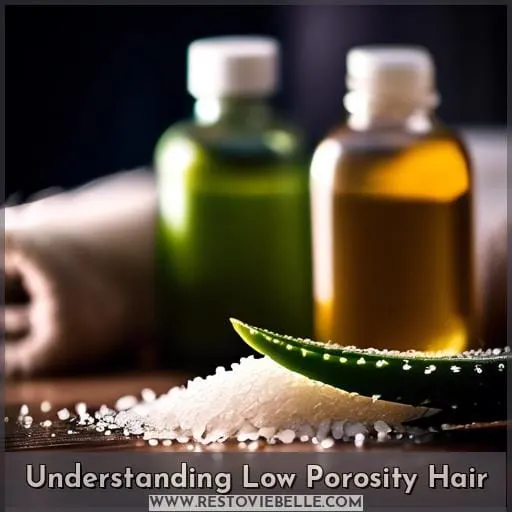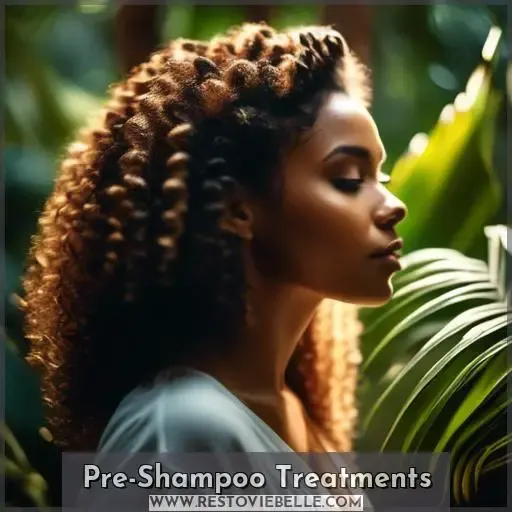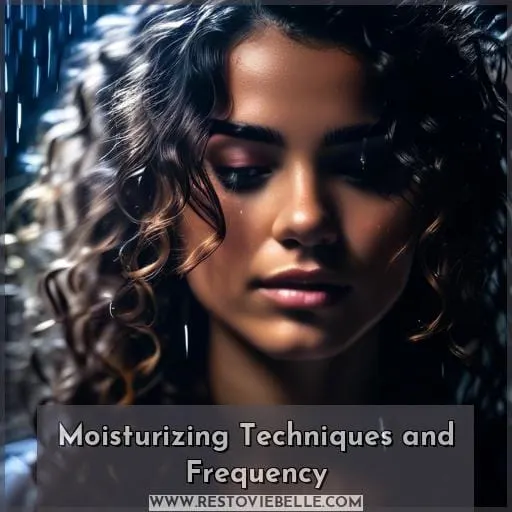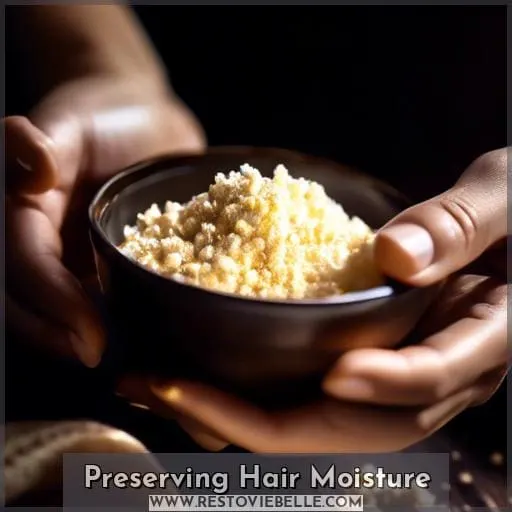This site is supported by our readers. We may earn a commission, at no cost to you, if you purchase through links.
 Struggling with low porosity hair can feel like a battle against nature itself. You’ve tried everything, yet your locks remain thirsty, repelling moisture like a waterproof coat.
Struggling with low porosity hair can feel like a battle against nature itself. You’ve tried everything, yet your locks remain thirsty, repelling moisture like a waterproof coat.
It’s not just about slathering on more products; it’s about understanding the science behind your strands. In this guide, we’ll unlock the secrets to infusing your low porosity hair with lasting hydration.
Get ready to transform your hair care routine and embrace the luscious, moisturized locks you’ve been dreaming of.
To moisturize low porosity hair, use heat during deep conditioning and apply light products that penetrate easily. Low porosity hair requires methods like pre-poo treatments and water-based styling products to maintain hydration.
Table Of Contents
- Key Takeaways
- Understanding Low Porosity Hair
- Pre-Shampoo Treatments
- Deep Conditioning With Heat
- Selecting Lightweight Moisturizers
- Moisturizing Techniques and Frequency
- Preserving Hair Moisture
- Frequently Asked Questions (FAQs)
- Can you permanently alter the porosity of your hair?
- How does the weather affect low porosity hair, and how can you protect it?
- Are there specific haircuts or styles that work better for low porosity hair?
- How do hard water and swimming in chlorinated pools impact low porosity hair?
- What are the best ways to detangle low porosity hair without causing breakage?
- Conclusion
Key Takeaways
- Utilize pre-shampoo treatments with natural oils like grapeseed or argan oil to add moisture and manageability before shampooing, which is especially beneficial for low porosity hair that tends to repel water and is prone to product buildup.
- Apply heat when deep conditioning to open up the tightly bound cuticles of low porosity hair, allowing for better moisture penetration; avoid protein treatments that can be too heavy.
- Select lightweight, water-based moisturizers and leave-in conditioners that contain humectants such as glycerin or aloe vera to hydrate the hair without causing buildup, and use a clarifying shampoo regularly to prevent buildup.
- Maintain hair moisture by moisturizing a couple of times a week, using water and a leave-in conditioner for daily hydration, and opting for protective styles and satin pillowcases to minimize moisture loss.
Understanding Low Porosity Hair
If you’re struggling with low porosity hair, understanding its characteristics and challenges is key.
By determining your hair’s porosity, you can tailor your moisturizing routine for better hydration.
Let’s explore how to keep your low porosity hair well-moisturized and healthy.
Characteristics and Challenges
One often encounters a unique set of challenges when dealing with low porosity hair, as it’s resistant to moisture and can be difficult to manage.
This type of hair, characterized by its tightly bound cuticles, tends to repel water, making it prone to product build-up.
Such hair often feels dry and tough, appearing dull and lackluster. Understanding these characteristics is crucial in tailoring your hair care approach to overcome these challenges effectively.
Determining Your Hair’s Porosity
Determining your hair’s porosity is a crucial step in understanding how to effectively moisturize and care for your locks.
- Perform the float test: Drop a strand in water and observe if it floats or sinks.
- Try the slip and slide test: Slide fingers up a strand to feel for bumps.
- Consult a hair porosity chart to compare characteristics.
- Understand hair porosity types and levels to tailor your porosity hair care routine.
Pre-Shampoo Treatments
If you’re struggling with low porosity hair, pre-shampoo treatments can be a game-changer for your hair care routine.
These treatments, known as pre-poos, help to add moisture and make your hair more manageable before you even begin to shampoo.
By using suitable oils or masks, you’re setting the stage for softer, more hydrated locks that resist breakage and retain length.
Benefits of Pre-Poo for Low Porosity Hair
After understanding the tightly bound cuticle layer of low porosity hair, you’ll find that pre-shampoo treatments, or pre-poos, are a game-changer, as they help to mitigate moisture resistance by prepping your strands for hydration.
Opt for natural oil selection like grapeseed or argan, which penetrate more easily than heavier oils. Pre-poo application should be thorough, section by section, to ensure even coverage.
Incorporating heat cap usage can further enhance the treatment’s effectiveness by opening the cuticles. This step is crucial in your daily hydration routine and complements protective styling options.
Emollients and humectants in your deep conditioning can provide additional nourishment, while avoiding protein treatments that may be too heavy for low porosity natural hair.
Suitable Oils and Masks
Transitioning from the benefits of pre-poo treatments, you can enhance the moisture retention of your low porosity hair by selecting suitable oils and masks for pre-shampoo applications.
- Light oil blends: Mix lightweight oils like argan or grapeseed for a non-greasy pre-poo.
- Moisturizing masks: Look for hydrating ingredients that penetrate without heaviness.
- DIY treatments: Create homemade recipes with aloe or honey for natural hydration.
- Hot oil baths: Warm oils gently to open cuticles before shampooing.
- Natural hair friendly tools: Use wide-tooth combs and sleep with silk to prevent moisture loss.
Deep Conditioning With Heat
To effectively moisturize low porosity hair, it’s essential to open up the cuticles to allow moisture to penetrate.
You can achieve this by incorporating heat into your deep conditioning routine. Apply your chosen conditioner, then gently introduce heat using a steamer, heat cap, or hooded dryer to enhance the absorption and retention of moisture.
Opening the Cuticle for Moisture
One should always apply heat when deep conditioning low porosity hair. This technique is essential for lifting the tightly bound cuticle layer and allowing moisture to penetrate the hair shaft.
Introduce a steam treatment or cover with a heat cap to enhance the efficacy of your overnight mask or conditioner.
To prevent product buildup, use a clarifying shampoo and opt for water-based products for daily moisture without the weight.
Heat Application Techniques
For lasting hydration of your low porosity hair, incorporate heat application techniques during deep conditioning to effectively open the cuticle for optimal moisture absorption.
- Embrace the warmth of hot oil treatments, letting them rejuvenate your strands from within.
- Feel the transformation as a steaming cap gently lifts each cuticle, ushering in moisture.
- Revel in the softness and manageability that heat application bestows upon your tresses.
- Trust in the science of low porosity hair care, as heat becomes your ally in the quest for hydration.
Selecting Lightweight Moisturizers
When you have low porosity hair, it’s essential to select moisturizers that hydrate without heaviness. You’ll want to reach for water-based products that contain humectants like glycerin or aloe vera, which attract and retain moisture effectively.
Avoid heavy oils and butters that can coat the hair and prevent moisture penetration, leaving your locks feeling greasy and weighed down.
Water-Based Products for Hydration
Following the application of heat to open the cuticle for deeper moisture penetration, selecting the right moisturizers is crucial for low porosity hair.
You’ll want to opt for lightweight, water-based products that hydrate without weighing down your strands. These products should be rich in humectants like glycerin, aloe vera, and honey, which attract and retain moisture within the hair shaft.
Avoid heavy oils and butters such as shea butter and castor oil, which can create buildup and leave your hair feeling greasy rather than moisturized.
Avoiding Heavy Oils and Butters
When selecting moisturizers for your low porosity hair, it’s crucial to avoid heavy oils and butters that can weigh down your strands and lead to buildup.
Opt for lightweight, water-based products that enhance moisture without overwhelming your hair cuticle.
Incorporate clarifying treatments to prevent product accumulation and maintain hair elasticity.
Embrace moisture-locking techniques and protective styles to safeguard your hydration levels.
Moisturizing Techniques and Frequency
Maintaining the right moisture balance in low porosity hair can be a bit of a tightrope walk.
You’ll want to moisturize your hair whenever it feels dry, which might mean a couple of times a week for extra-dry hair, or once a week for most.
If your hair feels dry daily, don’t hesitate to hydrate with water and a leave-in conditioner to keep it feeling soft and manageable.
When to Moisturize Low Porosity Hair
You’ll need to assess your hair’s dryness level to determine the best moisturizing frequency for low porosity hair. Crafting a weekly routine that includes locking in moisture with overnight masks can be transformative.
For daily care, lightweight, water-based products are key. How often should you moisturize? Listen to your hair. Some may need hydration a few times a week, while others benefit from daily attention.
Explore product recommendations specifically designed for low porosity hair to ensure you’re using the most effective methods.
Daily Hydration Tips
For maintaining daily hydration in low porosity hair, regularly misting your strands with water can effectively keep them moisturized without the need for additional products.
Incorporate a leave-in conditioner application post-shower to seal in the moisture.
Adopt overnight treatments with water-based moisturizers to nourish deeply as you sleep.
Refine your daily hydration routine with moisture-locking techniques, such as applying a light oil after moisturizing to create a barrier that retains hydration throughout the day.
Preserving Hair Moisture
Once you’ve successfully moisturized your low porosity hair, it’s crucial to maintain that hydration.
Opting for protective styles like braids or twists can help stretch the time between washes and slowly absorb moisture.
Additionally, switching to satin pillowcases and accessories can minimize moisture loss and protect your hair from breakage while you sleep.
Protective Styling Options
While you’re working to keep your low porosity hair moisturized, incorporating protective styles like braids, twists, and locs can significantly help in preserving that moisture. These styles not only maintain hydration but also protect your strands from environmental stressors.
To optimize moisture retention, choose hair accessories that won’t cause breakage. Regular braid maintenance, including gentle cleansing and moisturizing the scalp, will promote scalp health and prevent dryness.
Embrace these styles as a creative and effective way to nurture your hair.
Satin Pillowcases and Accessories
During the night, using satin pillowcases and accessories can help preserve the moisture in your low porosity hair.
Satin’s smooth surface reduces friction, minimizing frizz and static. Unlike cotton, satin won’t absorb your hair’s natural oils, keeping it well-moisturized.
Consider a satin-covered hair bonnet for added nighttime hair protection. Its moisture-wicking properties ensure hydration is locked in, not lost.
Embrace this simple switch; your strands will thank you with their lustrous, healthy glow and reduced breakage.
Frequently Asked Questions (FAQs)
Can you permanently alter the porosity of your hair?
You can’t permanently alter the natural porosity of your hair to switch from low to high or vice versa.
While chemical treatments and heat can increase porosity temporarily by causing damage, these methods don’t change your hair’s inherent porosity.
How does the weather affect low porosity hair, and how can you protect it?
Humidity can wreak havoc on low porosity hair, causing it to feel dry and brittle.
To shield your locks, opt for lightweight leave-in conditioners and seal with a light oil.
Embrace protective styles and consider a humidifier for consistent moisture.
Are there specific haircuts or styles that work better for low porosity hair?
Layered cuts enhance volume and reduce weight, allowing better moisture access for low porosity hair.
Opt for styles that don’t compress your strands, like loose updos or free-flowing natural looks.
How do hard water and swimming in chlorinated pools impact low porosity hair?
Hard water and chlorinated pools can be a double-edged sword for your low porosity hair. They create a fortress against moisture. Hard water can lead to mineral buildup, making your hair feel stiff and prone to breakage.
Chlorine strips natural oils, leaving your locks dry and brittle.
What are the best ways to detangle low porosity hair without causing breakage?
To detangle low porosity hair without causing breakage, start with your hair wet and conditioned.
Use your fingers first to gently separate major tangles, then switch to a wide-tooth comb or a detangling brush, beginning at the ends and slowly working your way up to the roots.
Ensure your hair is thoroughly moisturized with a lightweight, water-based conditioner to ease the detangling process.
Taking your time and being gentle are key to preventing breakage and maintaining the health of your low porosity hair.
Conclusion
Navigating the world of low porosity hair is akin to unlocking a treasure chest with a very particular key.
Just as the right key turns the lock smoothly, understanding how to moisturize low porosity hair can transform your hair care journey.
From pre-shampoo treatments to selecting lightweight moisturizers, each step is a golden piece of the puzzle.
By incorporating heat during deep conditioning and opting for water-based styling products, you’re not just applying products; you’re inviting moisture into your hair’s inner sanctum.
Let this guide be your compass, leading you to the lush, hydrated locks you’ve always desired.
Your journey to mastering low porosity hair hydration isn’t just about following steps; it’s about celebrating your hair’s unique character and unlocking its full potential.











